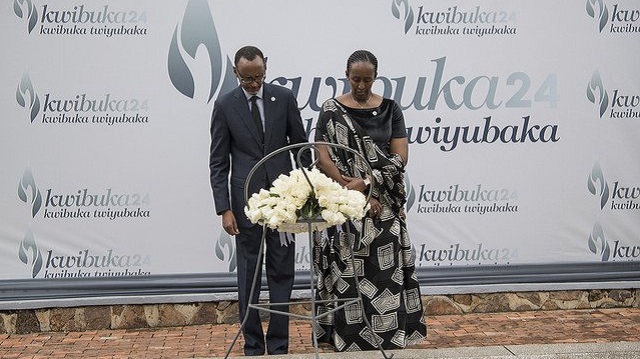
Reflect on the history of policy and practice of memory, justice, and recovery in the country over the past 24 years
COMMENT | SAMANTHA LAKIN | Rwanda is commemorating the 24th anniversary of the 1994 Tutsi genocide. This claimed the lives of between 800,000 and one million Tutsis and moderate Hutus over 100 days.
This is a good time to reflect on the history of policy and practice of memory, justice, and recovery in the country over the past 24 years. Two questions are especially pertinent: how have Rwandans engaged in various forms of memory after genocide? How have these processes been meaningful?
From a series of nearly 60 interviews conducted in the country since 2015, I have learned from a diversity of perspectives about memory and justice.
The findings suggest that genocide memory in Rwanda is diverse and dynamic. The interviewees’ often offered surprising and unexpected perspectives. These could not have been assumed from reading secondary reports or by observing the commemorations from a distance.
For example many people – including genocide survivors and former perpetrators – have a more holistic concept of justice than punishing perpetrators. And there is a huge desire for spaces for dialogue about how memories of genocide emerge and impact everyday life. These spaces would bring together survivors, perpetrators, returnees, and ordinary citizens. There is also a great desire for knowledge about how to use these memories to seek justice, validation, and promote coexistence; especially for future generations.
What we learnt
I interviewed genocide survivors, former perpetrators and ordinary citizens who were neither targeted for genocide nor took part in killing. Officials engaged in memory processes in Rwanda were also interviewed.
The commemoration ceremonies take place over 100 days, known as the Kwibuka period, beginning on April 7 each year. During this period, Rwandans visit village, district, or national memorial sites known as urwibutso where genocide victims are buried. There they hold memorial ceremonies which include listening to survivor testimonies and representatives from survivors’ organisations. Local and national leaders relate the history of the genocide, and sometimes perpetrators give testimonies.
Bodies of victims are still being found to this day, in pits or on farms. These bodies are reburied in communal memorial sites during the kwibuka period. Sometimes icyunamo (time of mourning) is observed. This is the cultural practice of informal mourning that takes place throughout the night, usually around a fire.
Regardless of the programme of kwibuka, each process ideally pays respect to genocide victims and works to bring Rwandans together.
Photos: Today’s 24th Commemoration of the Genocide against the Tutsi at the #Kigali Genocide Memorial – #Rwanda#Kwibuka24 | Remember – Unite – Renew pic.twitter.com/jHUahzfzMj
— Kigali Genocide Memorial (@Kigali_Memorial) April 7, 2018
But not all acts of memory are necessarily guided by the intention of achieving peace and justice, unity and reconciliation. Some of this is because of individual differences in perspective and resilience. Simply put, some people cope better with the harms that they suffered for various reasons, among them faith, education, and economic gains since the genocide.
Some individuals do not feel particularly connected to the memorial sites. Yet they still attend the ceremonies. This can cause conflicts of memory, especially when what is being remembered differs according to an individuals’s experience of the genocidal process. So it is important to ask Rwandans how urwibutso and kwibuka have or have not led to senses of justice, and what aspects of these processes are meaningful.
Local cultures of memory
It is also important to go back into the culture of Rwanda to inform the process of reflecting on and remembering the genocide. That serves to ensure that these processes are salient to Rwandans themselves, regardless of their backgrounds.
Achieving these goals is not an easy process. For example, proximity matters, as genocide survivors, genocidaires, returnees, and others still live together in close contact, in local communities and villages in Rwanda.
In addition, the genocide took place during a time of a civil war (1 October 1990-4 July 1994) and it was planned by a government that had abandoned its people. The government coerced many to participate in the killings. It used years of deliberate propaganda, hate speech, and dehumanisation tactics to indoctrinate others into hate ideology.
Many of the survivors were born of so-called mixed marriages, with one Hutu and one Tutsi parent. This reality challenges the binary nature of victimisation and perpetration of genocide in Rwanda.
Meaning making and memorialisation
The interviews raise further questions: what are Rwandans empowered by and what do they find meaningful about memorial sites and kwibuka, in order to sustain these processes over time?
For example, the research shows that, although some survivors feel validated when former perpetrators join them at commemoration ceremonies, others fear that requiring former genocidaires to attend when they still do not accept their guilt might result in a backlash.
Some individuals attend kwibuka to support their neighbours but do not consider it their “own story.” Others consider it to be one of the most significant and emotional days of their lives each year. Some embrace kwibuka as a chance to remember their loved ones among the comfort of friends and neighbours. Yet, others fear it, because of the retraumatisation, grief, depression, and anger they might feel.
These are some examples of the diverse perspectives of kwibuka, all of which are valid and coexist in the same physical and emotional space every April in Rwanda.
*****
Samantha Lakin is a PhD Candidate, Strassler Center for Holocaust and Genocide Studies; Fulbright Scholar, Clark University. Eric Ndushabandi, Director, Institute of Research and Dialogue for Peace, Rwanda, co-authored this article.
 The Independent Uganda: You get the Truth we Pay the Price
The Independent Uganda: You get the Truth we Pay the Price



